|
Bobcats | Bobcat Overview | Bobcat Damage Assessment | Bobcat Damage Management | Bobcat Resources | Bobcat Acknowledgments | ICWDM | Wildlife Species Information |
Damage Prevention and Control Methods
Exclusion

Use woven-wire enclosures to discourage bobcats from entering poultry and small animal pens at night. Bobcats can climb, so wooden fence posts or structures that give the bobcat footing may not be effective. Bobcats also have the ability to jump fences 6 feet (1.8 m) or more in height. Use woven wire overhead if necessary. Fences are seldom totally effective except in very small enclosures.
Cultural Methods
Bobcats prefer areas with sufficient brush, timber, rocks, and other cover, and normally do not move far from these areas. Keep brush cut or sprayed around ranches and farmsteads to eliminate routes of connecting vegetation from bobcat habitat to potential predation sites.
Frightening
Use night lighting with white flashing lights, or bright continuous lighting, to repel bobcats. You can also use blaring music, barking dogs, or changes in familiar structures to temporarily discourage bobcats.
Repellents, Fumigants, and Toxicants
No chemical repellents, fumigants, or toxicants are currently registered for bobcats. A hindrance to development of toxicants is the bobcat’s preference to feed on fresh kills.
Trapping
Bobcats are more easily trapped than are coyotes or foxes, but the bobcat’s reclusiveness makes set locations difficult to find. When hunting, bobcats use their sense of smell less than coyotes do, so lures and baits are usually not effective. The bobcat’s acute vision, hearing, and inquisitiveness however, can be capitalized upon. Even with the best sets, bobcats cannot be lured from their course of travel more than a few yards (m). The bobcat’s use of dense cover for capturing rodents and rabbits can be used in capture techniques to guide the animal or even its footsteps.
In the past, the demand for bobcat pelts was moderately high due to fur values. This had encouraged late fall and winter harvest periods. Also, the bobcat’s high fur quality attracts harvest for recreation or utility. If bobcat depredations are common over time, consider inviting a fur trapper to take bobcats during prime fur periods. Fewer bobcats may result in less com-petition for native foods and less depredation. Fur trappers may undertake the capture and relocation of bobcats during spring and summer months from areas where depredations are occurring in return for fur trapping rights during fall and winter months.
Many of the same sets used for foxes and coyotes will also catch bobcats. Few sets that target bobcats will catch other predators. Bobcats can be led by guide sticks or brush to dirt hole or flat sets where proper lures are used.
Leg hold Traps. Steel leg hold traps, Nos. 2, 3, and 4 are commonly used to capture bobcats. Trap size selection depends on the area and weather conditions. For coarse-textured sandy soils, use a No. 2 coil spring trap. Use a No. 3 trap for wet or fine-textured clay soils. Use No. 4 traps for frozen soils or in deep snow sets.
A bobcat is easy to hold, but sometimes more power and jaw spread is required than a No. 2 coil spring provides. The bobcat’s foot may be too large for proper foot placement and a good catch. Guide sticks and stones can be used.
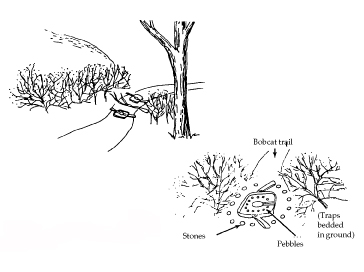
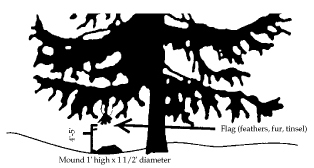
Bobcats prefer fresh baits such as rabbit, muskrat, or poultry. Scattered bits of fur and feathers work well. Bobcats can be drawn to traps by “flags” hung from trees or rocks located near trap sets (Fig. 4). Suspend flags about 4 feet (1.3 m) above the ground with fine wire or string. A combination of stiff wire with string attached to its end prevents entangling in tree branches. Where animal parts are illegal, aluminum foil or jar lids or imitation fur can be used. Location is the key to trapping bobcats. If the location is not correct, no flags or baits will work.
A flag set uses a piece of fur or a couple of feathers suspended about 4 feet (120 cm) above ground with fine wire or string. Build a small mound of soil under the flag 1 foot (30 cm) high and 2 feet (60 cm) in diameter. Bobcats step onto these mounds to reach the flag. Bury steel leg hold traps in the mound. Steel leg hold traps can also be used in other sets. See instructions in the Mountain Lions chapter.
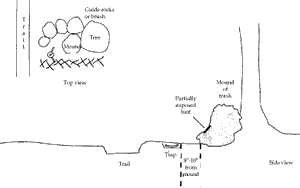
Trash or mound sets take advantage of bobcats covering their scat and leftover food (Fig. 5). This set is very common. Pull up a pile of trash or litter over a large bait, to mimic bobcat behavior. A smaller mound can be made with urine poured over the trash. These sets are useful where exposed baits are illegal. Both sets should be used where backing such as rocks or trees are available. Place a steel leg hold trap and guide sticks in front of trash pile sets.
Body-gripping Traps
Body-gripping traps are very effective killer traps for eliminating bobcats. These kill traps are spring-loaded. When the trigger is released, the trap closes on the animal in a scissors-like action. An example of this type of trap is the Victor® No. 330 Conibear®. This trap, and others like it, can be very dangerous to use, breaking arms, or killing large dogs if improperly set. Check local regulations to determine if they are legal to use in your area. For bobcats, set these traps in trails at the base of a cliff or in brush. Use bait or lures beyond the trap to entice the bobcat to walk through it. Strategic bait placement also keeps bobcats preoccupied.
These sets can be made in dense cover in trails, at the entrances to dens, or at gaps in fences or brush where bobcats travel. These traps can also be set in entrances to cubbies constructed to trap bobcats. Place an attractive bait at the rear of the cubby and place the kill trap so that the bobcat must go through it to reach the bait. See Mountain Lions for other sets made with body-gripping traps.
Specific instructions on trapping bobcats are found in Boddicker (1980). Extensive bobcat trapping methods can also be found in Weiland (1976), Young (1941), Johnson (1979), and Musgrave and Blair (1979). Check all local and state laws for using traps, snares, baits, or lures.
Wire Cage Traps. Very large cage traps, made of wire mesh or metal, when properly set, are effective. Commercial traps from 15 x 15 x 40 inches (38 x38 x 100 cm) up to 24 x 24 x48 inches (60 x 60 x 120 cm) are available. See [Supplies].
Use brush or grass on the top and sides of the cage to give the appearance of a natural “cubby” or recess in a rock outcrop or brush. Traps should be set in the vicinity of depredations, travelways to and from bobcat cover, and around bobcat trails, dens, and hunting sites. Cover the cage bottom with soil. Bait the cage with poultry, rabbit, or muskrat carcasses, or live animals. Check local and state laws for restrictions.
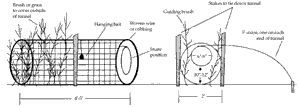
Snares. Snares are very effective for bobcats but require expertise and caution. When properly set, a snare can be used to either kill or restrain a bobcat. Snares can be placed in the same locations and situations as body-gripping traps. They are particularly effective in cubby sets, bobcat runways, and den entrances (Fig. 6). Properly placed, snares offer the advantages of body-gripping traps without the danger to pets and non-target wildlife.
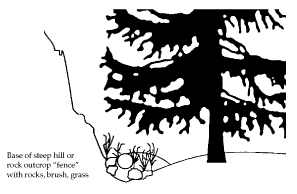
Set snares in trails where bobcats are known to travel (Fig. 7). Baits and lures are usually not used with snares and may hinder success. Use camouflage only to break up some of the outline of the snare, preferably with native material, like grasses. Do not tie camouflage material to the loop of the snare. Spring-loaded snares work best. Put “memory” into the snare by placing tension on the inside of the lock against the cable with your finger as you close the snare once or twice. This prevents a bobcat from walking through a snare. Cables respond to the memory by closing easily.
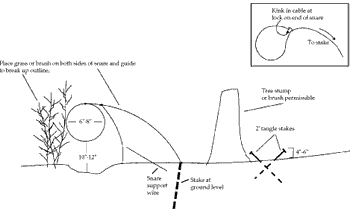
Kill snares actually kill the captured bobcat and are most often used during
the furbearer season or for animals for which relocation has failed (Fig. 8). They are best made from fine steel cable, 1/16 inch (0.15 cm) or 5/64 inch (0.2 cm) in diameter. Positive locks work well. Set kill snares with the bottom of the loop about 10 to 12 inches (25 to 30 cm) off the ground with a loop 6 to 8 inches (15 to 20 cm) in diameter. This loop must be set perpendicular to the trail.
Live snare sets capture and hold bobcats alive. They differ from kill snare
sets by their cable size, locks, and entanglement precautions. Larger
cables and relaxed locks on live snare sets can reduce injury if set properly.
Relaxed locks tighten onto animals but relax as the animal stops struggling.
This allows the animal to breath normally and regain composure.
Kill snares may be tied off to a 3-inch (7.5-cm) diameter tree or larger . To
aid quick kills, hammer 2-foot (60-cm) stakes into the ground, leaving 6 to 8
inches (15 to 20 cm) aboveground. Kill-snare locks (Gregerson, Camlock, Thompson, Keflock) are in several of the supply catalogs listed in [Supplies].
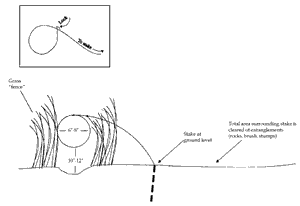
The live snare set (Fig. 9) requires more expertise than the kill snare set. Also, capture and transport of bobcats is very dangerous. Use 3/32-inch (0.25-cm) steel cable 6 to 8 feet (1.9 to 2.5 m) long. Use snares with high quality swivels located midway or closer to the loop. Stake live snares to the ground with steel stakes, hammered to just below ground level. Use loop sizes as in the kill snare set. Clear brush and other entanglements from
the area.
Use extreme caution when releasing a snared animal. Catch poles with adjustable steel nooses, thick leather gloves or gauntlets, and other protective clothing are necessary. Immobilizing drugs such as ketamine hydrochloride should be accessible. Two people should handle captures; one at the neck and the other at the back feet to remove the snare. Cut a 1/2- x 4-inch (1.2- x 10-cm) slot from the bottom up toward the center of a 3- x 3-foot (1- x 1-m), 5/8-inch (1.6-cm) or larger piece of plywood. A handle should be attached at the upper end. Place the plywood between you and the snared animal and let the cable run through the slot as you approach, keeping the cable tight. Check live snare sets frequently to avoid unnecessary stress and loss of captured bobcats to predators, such as eagles, coyotes, and mountain lions. See [Supplies] for suppliers of bobcat snares. Always ask for expert advice before attempting live captures. Extensive instructions on snaring can be found in Grawe (1981) and Krause (1981).
Shooting
Bobcats respond to predator calls at night and can be shot. Use a red, blue, or amber lens with an 80,000-to 200,000-candlepower (lumen) spotlight to locate bobcats.
Dogs trained to track bobcats can be useful in removing problem animals. Bobcats can be shot after being treed.
Bobcats may develop a time pattern in their depredations on livestock or poultry. You can lie in wait and ambush the bobcat as it comes in for the kill. Rifles of .22 center fire or larger, or shotguns with 1 1/4 ounces (35 g) or more of No. 2 or larger shot are recommended, since bobcats are rather large and require considerable killing power.
Summary of Damage Prevention and Control Methods
Exclusion
Fence poultry and other small livestock located near human residence.
Cultural Methods
Clear brush and timber in and around farmsteads and between large expanses of bobcat habitat and farmsteads.
Frightening
Place flashing white lights, loud music, or dogs with livestock
Repellents
None are registered.
Fumigants
None are registered.
Toxicants
None are registered.
Trapping
Fur trappers may be willing to trap and remove bobcats year-round in problem situations in exchange for trapping rights when pelts are prime.
Steel leg hold traps (No. 2, preferably No. 3 offset or No. 4 offset or padded).
Cage traps, 15 x 15 x 40 inches (38 x 38 x 100 cm) up to 24 x 24 x 48 inches (60 x 60 x 120 cm).
Large body-gripping traps (Victor® No. 330 Conibear®) in “cubby” sets.
Kill snares (1/16- or 5/64-inch steel [0.15-or 0.2-cm] cable, 6 to 8 feet
[1.9 to 2.5 m] long).
Live snares (3/32-inch [0.25-cm] steel cable, 6 to 8 feet [1.9 to 2.6 m] long) with protective clothing and equipment.
Shooting
Predator calls, experienced trail hounds, and center fire rifles.
|
Bobcats | Bobcat Overview | Bobcat Damage Assessment | Bobcat Damage Management | Bobcat Resources | Bobcat Acknowledgments | ICWDM | Wildlife Species Information |
